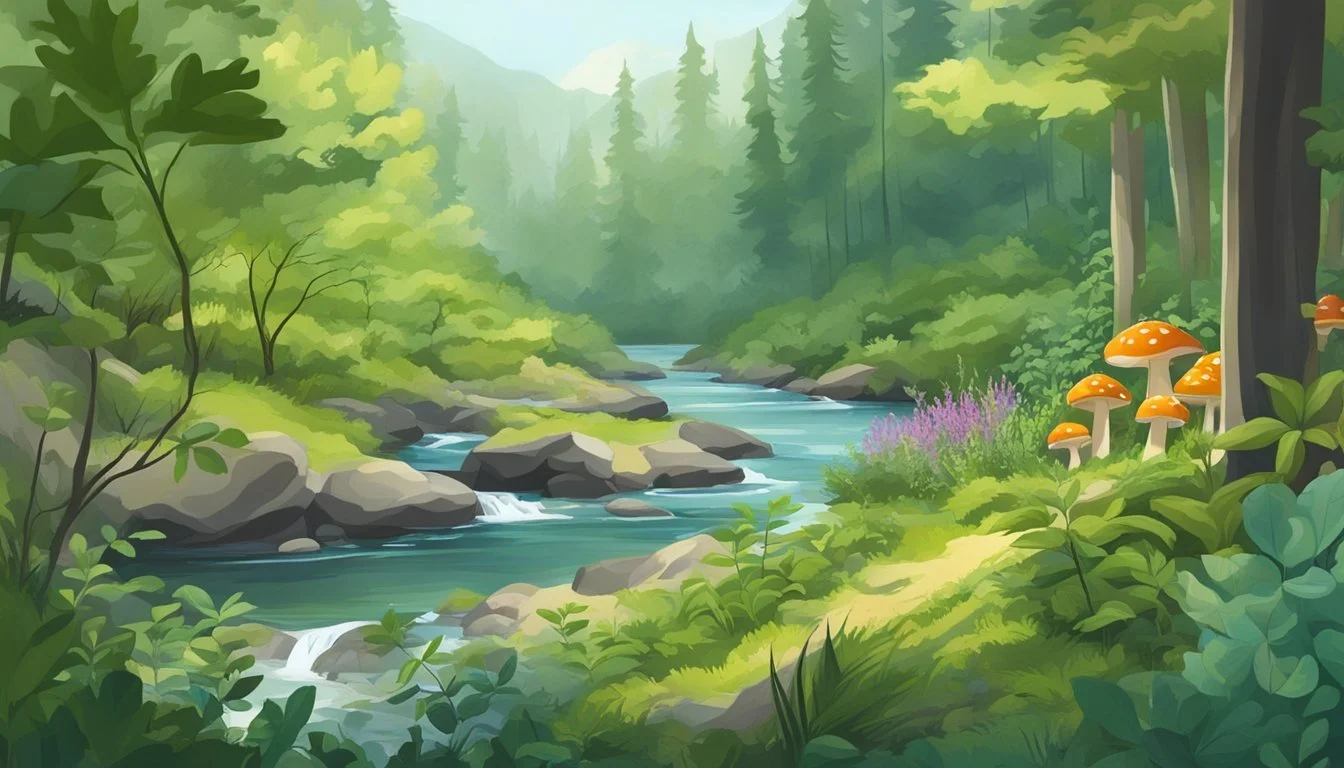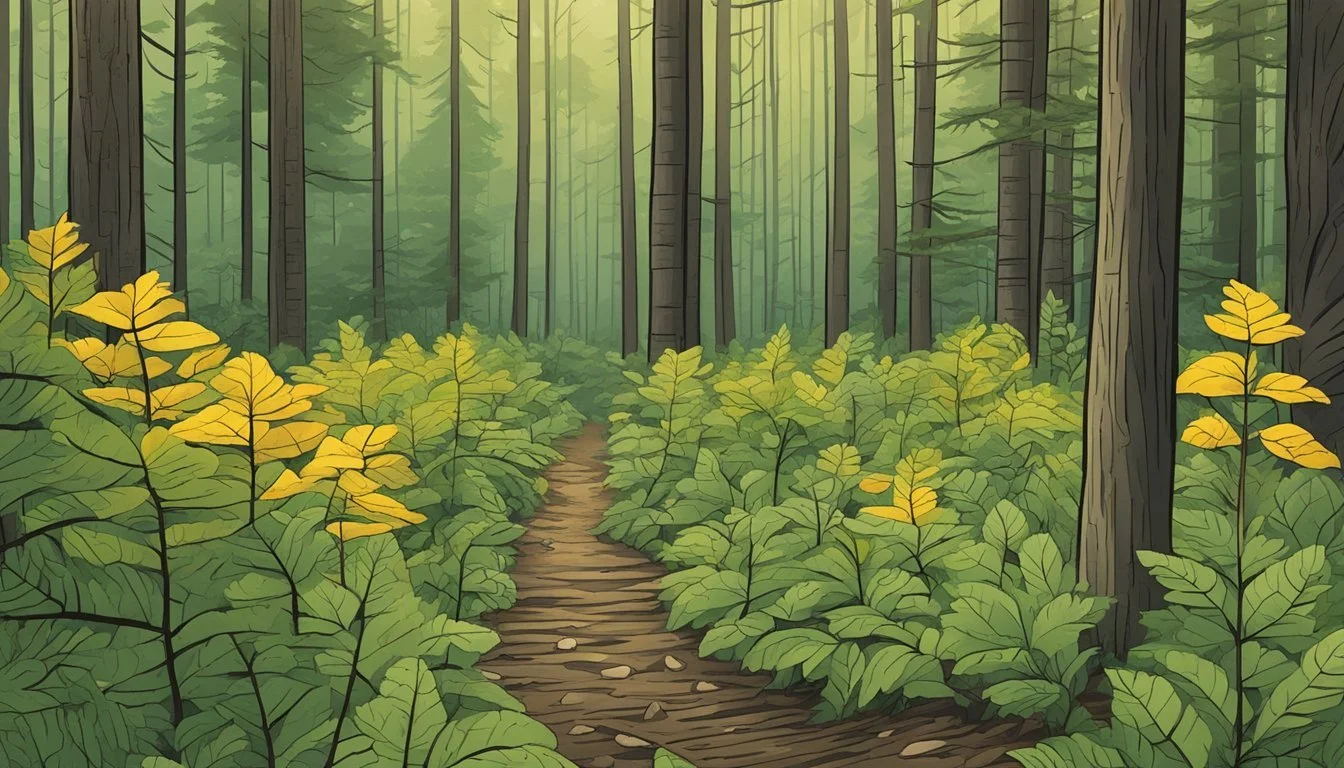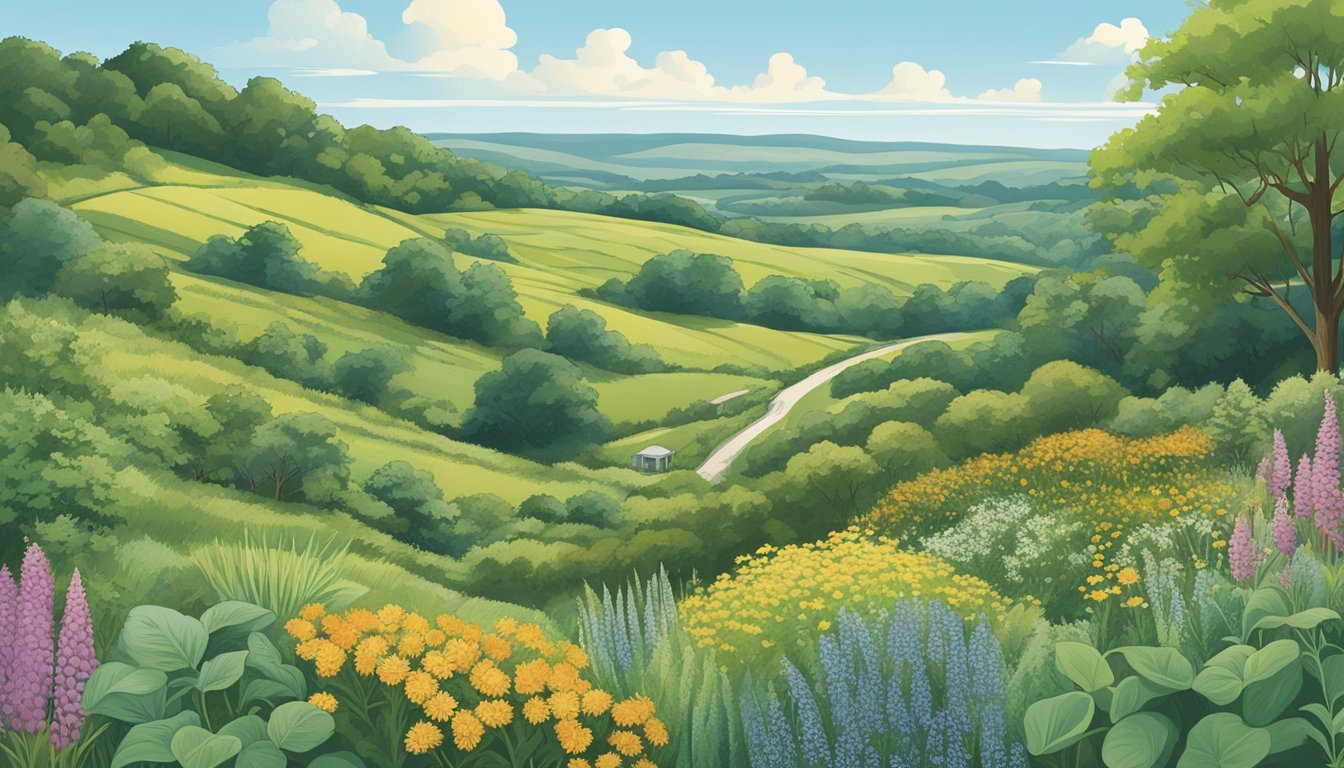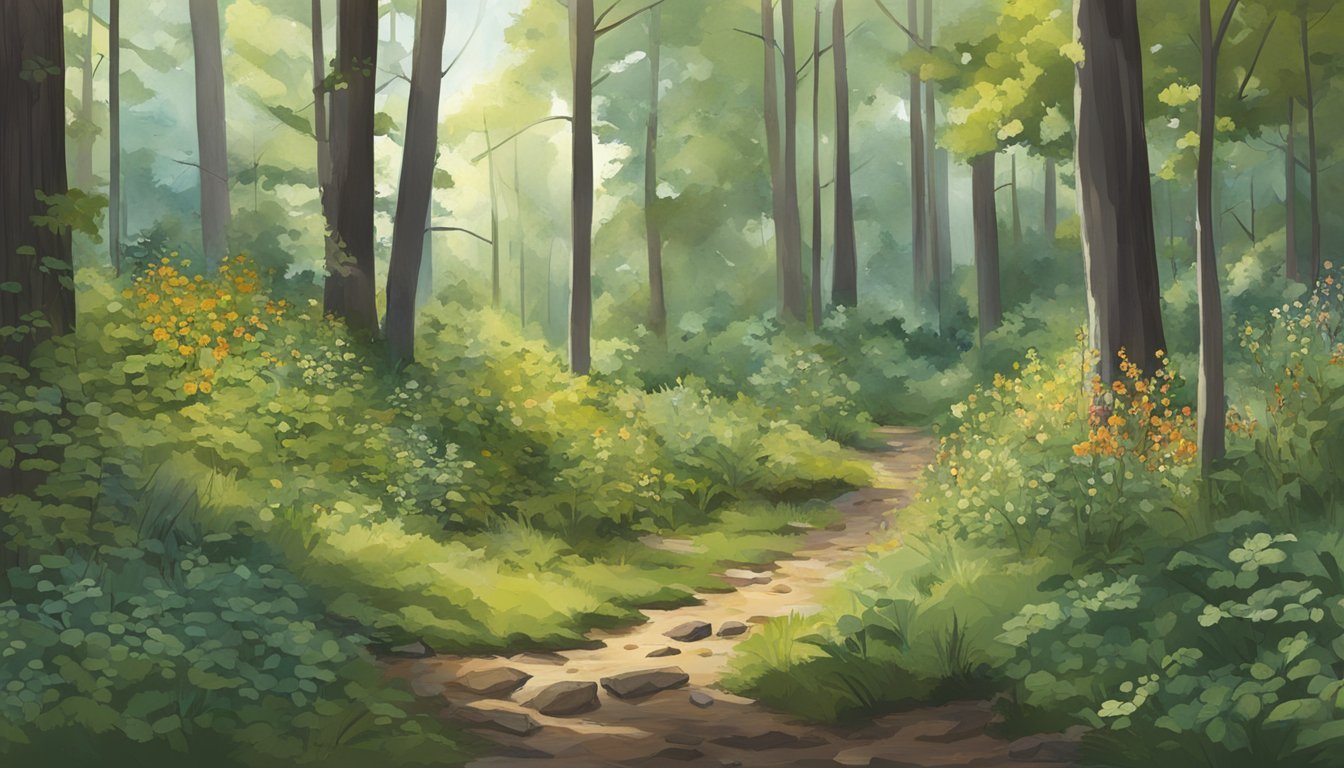Native Edible Plants in Wisconsin
A Guide to Foraging Local Flavors
This Article is Part of Foraging Guide for All 50 US States
(What wine goes well with lobster?)Wisconsin's landscape is a treasure trove of native edible plants, offering a diverse palette of flavors and nutritional benefits. The state's rich forests, wetlands, and prairies are home to a variety of flora that have been integral to the diet of indigenous peoples and wildlife for centuries. These plants not only contribute to the region's biodiversity but also provide foraging opportunities for those interested in incorporating wild food sources into their diets. Understanding which plants are edible is essential for anyone exploring Wisconsin's natural bounty.
Several species of edible plants in Wisconsin are recognized for their culinary and medicinal uses. Berry-bearing shrubs like the wild raspberry and blackberry provide sweet summer treats, while the common milkweed and dandelion offer versatile greens for salads. Roots such as the wild ginger and Jerusalem artichoke can be harvested for their unique flavors and textures. Each edible plant has a season where it is best harvested, and proper identification is crucial to ensure both safety and sustainability.
Fostering an appreciation for these native edibles encourages a deeper connection with the local environment and supports conservation efforts. In addition to human use, native edible plants play a vital role in the ecosystem, supporting wildlife through food and habitat. The incorporation of native edible plants into landscaping can create aesthetically pleasing and functional green spaces that sustain local ecosystems. Engaging with Wisconsin's native edibles is a rewarding endeavor that promotes ecological awareness and a sustainable relationship with the land.
Interested in Mushroom Hunting in Wisconsin?
Wisconsin is a prime destination for mushroom enthusiasts. The state's diverse woodlands, from the Northwoods to the Driftless Area, offer a wide range of edible mushrooms. Morels, chanterelles, chicken of the woods, and lobster (What wine goes well with lobster?) mushrooms are among the most popular species. The best time to hunt varies depending on the mushroom type and location within the state. Hunters should always properly identify mushrooms and obtain landowner permission before foraging on private property. With its rich forests and ample rainfall, Wisconsin provides an exciting adventure for both novice and experienced mushroom hunters.
👉 Guide on Mushroom Hunting in Wisconsin
Historical Use of Native Edibles
In Wisconsin, the historical use of native edible plants is deeply rooted in the practices of Indigenous peoples and was later adapted by early European settlers. These practices included the identification, harvesting, and culinary use of various native species for sustenance and medicinal purposes.
Indigenous Practices
Indigenous tribes in Wisconsin, such as the Ojibwe, Ho-Chunk, Menominee, and others, had extensive knowledge of the local flora and its utility. They cultivated plants such as the wild rice (how long does wild rice last?) (Zizania palustris), which continues to be a significant cultural and food resource. Corn (maize), beans, and squash, known as the "Three Sisters," were grown together to create a sustainable farming system that maximized yield and soil health.
Traditional harvesting techniques were employed to ensure the sustainability of plant populations. For example, berries like blueberries (how long do blueberries last?) (Vaccinium spp.) and cranberries (Vaccinium macrocarpon) were collected by hand without damaging the plants, ensuring their availability for the next season. Food preparation methods were adapted to the resources available, with many plants consumed raw, dried, or cooked in simple yet nutritious dishes.
Early Settlers' Adaptations
European settlers arriving in Wisconsin learned from Indigenous peoples and incorporated native plants into their diets. Plants such as maple (Acer spp.) and birch (Betula spp.) trees were tapped for their sap, which was then processed into syrup and sugar. This practice became a staple method for producing sweeteners.
Settlers adopted native plants for their culinary uses as well. Pawpaw (Asimina triloba) fruit, for instance, became a popular food due to its tropical flavor and custard-like texture. Edible greens like dandelion (Taraxacum officinale) and nettles (Urtica dioica) were used in salads, teas, and as cooked vegetables (how long do cooked vegetables last?). The settlers also preserved the tradition of harvesting wild rice and recognized the value of this indigenous grain.
Common Name Scientific Name Indigenous Uses Settlers' Adaptations Wild Rice Zizania palustris Staple food, harvested from canoes Kept same harvesting methods, integrated into local cuisine Blueberries Vaccinium spp. Hand-harvested, eaten fresh or dried Used in jams, pies, and medicinal remedies Maple Acer spp. Tapped for sap, sweetening agent Developed commercial syrup production
Through these practices, both Indigenous peoples and early settlers maintained a connection to the land, emphasizing the importance of Wisconsin's native edible plants in the region's history and culture.
Identifying Native Edible Plants
When foraging for native edible plants in Wisconsin, it is critical to make accurate identification to ensure that the plants are safe to consume. Detailed observation of leaf morphology and the characteristics of flowers and fruits are essential steps in this process.
Leaf Morphology
Identifying edible wild plants begins with the careful examination of leaves. A basic understanding of leaf shapes, edge types, and arrangement patterns on the stem can help distinguish edible plants from inedible or toxic ones.
Leaf Shapes: Look for simple leaves with recognizable shapes such as cordate (heart-shaped), lanceolate (lance-shaped), or ovate (egg-shaped).
Edge Types: Edges can be smooth (entire), toothed (serrated), or lobed. For example, the dandelion, a common edible green, has deeply toothed leaves.
Arrangement Patterns: Leaf arrangement on the stem can be opposite, alternate, or whorled. Wild leeks, also known as ramps, feature broad, smooth leaves that grow in an alternate pattern.
Flower and Fruit Identification
Flowers and fruits provide crucial clues to the identification of edible shrubs and trees. Distinctive colors, shapes, and sizes can differentiate between species and their edible parts.
Flowers: Observe the color, number of petals, and shape. For instance, the wild strawberry has small, white flowers with five petals.
Fruits: Note the color, texture, and taste of fruits. Safe, edible fruits like blueberries are often plump, with a sweet flavor, while toxic fruits can have a stark bitterness.
When identifying edible plants, be mindful of look-alikes that may be harmful. Proper field guides and local knowledge can greatly assist in safe foraging practices in Wisconsin's diverse ecosystems.
Edible Trees and Shrubs
Wisconsin hosts a variety of trees and shrubs that provide edible parts, like fruits, seeds, and nuts (how long do nuts last?), valuable both for human consumption and wildlife.
Common Trees with Edible Parts
In Wisconsin's forests, several trees are noteworthy for their edible offerings. The Black Cherry (Prunus serotina) stands out with its dark, ripe berries that mature in late summer and are often used to make jams and jellies. These trees thrive in full sun and contribute significantly to wildlife value, as numerous birds and mammals feast on the cherries (how long do cherries last?). Another important species is the White Ash (Fraxinus americana), whose seeds, known as keys, can be consumed after removing the winged encasements. Although not commonly eaten today, they have been used historically by indigenous peoples.
Tree Species Edible Parts Best Time to Harvest Black Cherry Berries Late Summer White Ash Seeds Late Spring to Fall
Shrub Varieties for Foraging
Wisconsin is also home to several berry-producing shrubs that are popular with foragers. The wild blueberry (Vaccinium angustifolium), recognized for its small but flavorful fruit, is a common find. These shrubs prefer acidic soils and often occupy spaces where the forest meets open areas. Cranberry (Vaccinium macrocarpon) bushes are frequently found in the state's wetlands and bogs, with fruits ready for harvest in fall. Additionally, the Autumn Olive (Elaeagnus umbellata), though not native and considered invasive, produces berries high in antioxidants and can be found in full sun along the edges of woods and fields.
Shrub Variety Edible Parts Best Time to Harvest Blueberry Berries Summer Cranberry Berries Fall Autumn Olive Berries, seeds Late Summer to Fall
These species not only support local wildlife but can also offer nourishing ingredients for those interested in foraging.
Herbaceous Plants and Wildflowers
Wisconsin's native flora includes a rich variety of herbaceous plants and wildflowers, many of which serve culinary and medicinal purposes. These plants are deeply woven into the state's natural fabric and offer foragers a palette of flavors and health benefits.
Foraging for Greens and Herbs
Foragers in Wisconsin can find a vast array of greens and herbs to enhance their culinary creations. Commonly sought-after greens include the ramp (Allium tricoccum), also known as wild leek, recognized for its strong garlic-onion flavor. This perennial plant is foraged for its leaves and bulbs in the spring. When harvesting ramps, sustainable practices such as taking only a portion of a patch and avoiding the whole bulb are important to ensure their availability for future seasons.
Dandelion (Taraxacum officinale): Despite its reputation as a weed, the dandelion's leaves are nutritious and can be used in salads, while its roots and flowers offer medicinal properties, aiding digestion and liver health.
Wild Strawberry (Fragaria virginiana): Both the leaves and fruit of wild strawberries are edible, with the leaves being rich in vitamin C and often used in teas.
Wildflowers with Culinary Uses
Wisconsin's wildflowers not only enhance the landscape but also contribute unique flavors and potential health benefits in the culinary world. Each wildflower comes with its own set of guidelines for safe and sustainable foraging.
Violet (Viola spp.): With delicate, edible flowers, violets offer a sweet flavor that can be used in desserts, salads, or syrups.
Bee Balm (Monarda spp.): Known for its colorful flowers and minty flavor, bee balm leaves and petals are consumable and can be steeped to make herbal tea.
Foragers should always correctly identify plants before consumption and respect the natural habitats. Additionally, they should be aware of any regulations regarding foraging in public spaces and private properties.
Seasonal Foraging Calendar
Wisconsin's diverse climate and ecosystems offer an abundance of native edible plants that vary with the seasons. Foragers can enjoy harvesting a range of species from morel mushrooms in spring to hearty fruit in late summer. This calendar outlines the optimal foraging times for key species within Wisconsin's four distinct seasons.
Spring
With the melt of winter's snow, spring ushers in the first bursts of forageable edibles in Wisconsin.
Morel Mushrooms: Typically found in late April to early June. Best searched for after a rain near elm, ash, and aspen trees.
Wild Leeks (Ramps): Harvestable from late March through May, usually found in wooded areas.
Summer
Summer's full swing brings a colorful palette of berries and early fruits, along with a variety of greens and flowers.
Berries: Varieties such as strawberries, raspberries, and blueberries peak from June through August.
Wild Asparagus: Found in roadside ditches and open fields, best harvested in early summer when stalks are tender.
Autumn
Autumn provides a hearty selection of nuts, fruits, and late-season greens before the onset of frost.
Edible Forest Fruits: Pawpaws and persimmons are ripe and ready to pick from late September to early October.
Berries Continuation: Late-fruiting berries, such as elderberries, can be collected through the end of September.
Winter
While winter may seem barren, dedicated foragers can still find edible plants through careful search.
Tree Bark: Certain trees like Slippery Elm have edible inner bark that can be harvested in winter.
Stored Nuts: Nuts gathered in autumn can be cracked and eaten throughout the winter months.
Culinary Uses and Nutrition
In Wisconsin, a bounty of native plants offers a variety of culinary uses and nutritional benefits. From sweet treats to savory meals, these indigenous plants can enrich the diet with flavors and nutrients unique to the region.
Preparing and Cooking
Wisconsin's edible native plants can be transformed into an array of dishes. Wild berries, such as serviceberries and chokeberries, can be eaten raw or used in baking to create pies and muffins. Nuts like hazelnuts are perfect for adding a crunchy texture to salads or for making a hearty trail mix. Plants like the wild leek can be pickled, offering a zesty condiment to meals. Fiddlehead ferns are typically cooked to eliminate their bitterness, making them a delicious side dish.
Herbs such as bee balm and wild bergamot can be dried and used to brew flavorful teas. These teas are not only delicious but are also treasured for their health benefits. Other native herbs and flowers are excellent for infusing oils and vinegars, bringing an aromatic touch to culinary creations.
Nutritional Benefits
The edibles from Wisconsin's flora are not just versatile in the kitchen but are also packed with nutrition. For instance, wild berries are often rich in antioxidants, vitamins (particularly vitamin C), and fiber, supporting overall health and well-being.
Plant Key Nutrients Wild Berries Antioxidants, Vitamin C, Fiber Nuts Healthy Fats, Protein, Vitamins Wild Greens Vitamins A and C, Calcium, Iron Herbal Teas Antioxidants, Varied Medicinal Properties
Foliage like dandelion leaves and nettles are sought after for their high vitamin A and C content as well as calcium and iron. They can be added to salads or incorporated into green smoothies. When consumed regularly, these native plants can contribute to a balanced diet, offering an impressive spectrum of essential nutrients.
Ecology and Conservation
The ecology of Wisconsin is deeply intertwined with the presence of native edible plants, which play a vital role in conservation efforts. These plants help sustain the local wildlife and maintain biodiversity, which is essential for a balanced ecosystem.
Supporting Local Wildlife
Native edible plants provide crucial habitats and food sources for a variety of wildlife species in Wisconsin. Plants like the wild strawberry (Fragaria virginiana) and the serviceberry (Amelanchier) are not only valuable to human foragers but are also essential for animals. For instance:
Bees and butterflies: These pollinators are attracted to plants like the purple coneflower (Echinacea purpurea) and wild bergamot (Monarda fistulosa), which offer plentiful nectar and pollen.
Birds and mammals: Many birds and mammals depend on fruit-bearing plants for sustenance. For example, the American cranberry bush (Viburnum trilobum) provides berries for birds, whereas the acorns from white oak (Quercus alba) are a food source for small mammals.
Consciously conserving these plants not only aids the local fauna but also ensures the health of the broader ecosystem.
Invasive vs. Native Species
Invasive species pose a significant threat to native edible plants in Wisconsin, often outcompeting them for resources and altering habitats. A proactive approach to controlling invasive species like garlic mustard (Alliaria petiolata) and buckthorn (Rhamnus cathartica) is critical to protecting indigenous flora. Efforts include:
Preventing Spread: Education on the impacts of invasive species and responsible foraging practices.
Restoration Projects: Removal of invasive species coupled with replanting native species to reclaim affected areas.
It is imperative to support biodiversity by defending native plants against invasive competitors. Conservation actions are essential to protect not just the rare and potentially endangered native species but also the integrity of Wisconsin's natural ecosystems.
Ethical Foraging and Sustainability
Ethical foraging in Wisconsin involves sustainable practices to ensure native plants remain robust for future generations. This section focuses on how individuals can gather native edibles sustainably and support their propagation.
Responsible Gathering Practices
When foraging for wild plants such as wild leek, berry-bearing shrubs, and native grasses, adhering to responsible gathering methods is crucial for sustainability. Foragers should:
Harvest selectively: Take only what they need and leave plenty for wildlife and regrowth.
Follow guidelines: Abide by local regulations and foraging seasons, especially for vulnerable species.
Use proper techniques: Cut or pick plants in ways that minimize harm and promote regrowth.
For example, foragers should harvest wild leeks by taking only a few leaves from each plant instead of uprooting the entire organism.
Propagation and Cultivation
By engaging in propagation and cultivation, foragers contribute to the sustainability of native edible plants. They can:
Plant seeds or spores: In areas they've foraged to encourage growth of species like native grasses.
Establish gardens: For cultivating wild edibles, easing pressure on natural populations.
Educating oneself on the life cycle of plants is vital for successful cultivation and propagation, ensuring that species like wild leek can thrive in both wild and garden settings.
Health Cautions and Plant Safety
Identifying edible plants in Wisconsin requires careful attention to avoid toxic species and ensure safe foraging practices.
Poisonous Look-Alikes
Numerous edible plants in Wisconsin have poisonous look-alikes that can pose serious risks to foragers. For example, the wild carrot (Daucus carota), also known as Queen Anne's lace, closely resembles the toxic water hemlock (Cicuta maculata). To avoid these dangers:
Study: Learn the distinct features of both edible plants and their poisonous counterparts.
Consult: Use reliable field guides or digital resources for identification.
Never Guess: If there's any uncertainty about a plant's identity, it's safer not to consume it.
Safe Foraging Techniques
Implementing safe foraging techniques is essential to prevent the consumption of toxic plants and mushrooms, and to maintain the integrity of the ecosystem. Foragers should:
Seek Permissions: Only forage in areas where it's legally permitted.
Take Care: Harvest in a way that allows plants to regrow.
Hygiene: Clean all foraged items thoroughly before consumption.
Start Small: Initially consume small quantities to check for personal adverse reactions.
Proper identification and foraging methods are critical for safety when seeking out edible species in the wild.
Appendix: Plant Profiles and Descriptions
This section provides detailed profiles of various native edible plants found in Wisconsin, including trees, shrubs, and herbaceous plants. Each profile encapsulates key information such as botanical description, hardiness zones, and flavor characteristics.
Trees
Sugar Maple (Acer saccharum)
Description: Renowned for its vibrant fall foliage, Sugar Maple is also a source of sap for making maple syrup.
Zones: Thrives in zones 3b to 8a.
Flavoring: The sap is boiled to produce a sweet maple flavor.
Shrubs
Common Elderberry (Sambucus canadensis)
Description: This shrub produces clusters of small, dark berries.
Zones: Found in zones 3 to 9.
Flavoring: Berries are often used to create jams, jellies, and elderberry wine.
Herbaceous Plants
Common Milkweed (Asclepias syriaca)
Description: Recognized by its large, pink, fragrant flower clusters and large, ovate leaves.
Zones: Suitable for zones 3 to 9.
Flavoring: Young shoots and pods can be cooked and have a flavor similar to asparagus.
Leadplant (Amorpha canescens)
Description: A leguminous shrub with compound leaves and spikes of purple flowers with orange anthers.
Zones: Does well in zones 2b to 9.
Flavoring: Leaves can be dried and used for a mild, mint-like tea.
Canadian Wild Ginger (Asarum canadense)
Description: Noted for its heart-shaped leaves and brown, jug-shaped flowers that hide near the base of the plant.
Zones: Prefers zones 4 to 6.
Flavoring: The root is aromatic and can serve as a ginger substitute.
Nodding Pink Onion (Allium cernuum)
Description: Features delicate, nodding blooms of soft pink and strappy leaves emerging from the ground.
Leaf Axils: Flowers grow from the leaf axils in spring and summer.
Zones: Grows well in zones 4 to 8.
Flavoring: The bulbs have a mild, onion-like taste and can be used in cooking.
Each plant included in this appendix has been selected for its edible qualities and relevance to the Wisconsin region. Users should ensure they have properly identified these plants and are aware of any potential look-alikes that may be toxic before consumption.
Glossary and Terminology
Edible: Suitable for consumption by humans without causing harm.
Bloom Time: The period during which a plant produces flowers.
Asclepias syriaca: Commonly known as common milkweed, a perennial plant native to Wisconsin that has edible parts and a bloom time in early to mid-summer.
Essential Oil: A concentrated hydrophobic liquid containing volatile aroma compounds from plants.
Minty Flavor: A term used to describe the cool, refreshing taste characteristic of plants in the mint family.
Strongly Flavored: Indicates a potent or intense taste attributed to certain edible plants.
Herb Tea: A beverage made by infusing the leaves, flowers, or stems of herbs in hot water.
Term Description Edible Suitable for eating by humans. Bloom Time The season when a plant flowers. Asclepias syriaca Also known as common milkweed, with edible young shoots and buds. Essential Oil Concentrated extracts from plants, carrying the scent or essence. Minty Flavor A taste resembling that of mint herbs. Strongly Flavored Describing edibles with a potent taste. Herb Tea A drink made by steeping herbs in hot water.
The above terms will aid in understanding the attributes and uses of native edible plants in Wisconsin.









